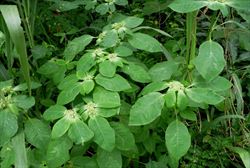- Worldwide distribution. In Australia, and most Pacific island countries.
- Aggressive, annual weed, of major economic and environmental importance. Grows rapidly, produces abundant seed during short life cycle. Forms dense canopies over crop plants – cocoa, coffee, cotton, maize, papaya, sugarcane, tea, rice.
- Stems erect, up to 60 cm, hollow, reddish-green, smooth, sparsely branched, with latex. Lower leaves alternate, upper opposite, up to 12cm long and 7cm wide, pointed tips and leaf stalks 1-4cm – shorter on upper leaves. Upper leaves with pale patches at base. Cup-shaped structurers (formed from leaf-like bracts) at top of stems each containing several male flowers, and a single female flower producing three seeds. No petals or sepals. Funnel-like opening - the gland.
- Spread: seed in water, mud on machinery/vehicles, livestock. Possibly, collected for ornamental and medicinal. use.
- Biosecurity: risk is unofficial introduction of seed and plants. Check imported machinery/vehicles and livestock.
- Biocontrol: none.
- Cultural control: hand-weed; slashing; mulch (5-10cm) to prevent seedling growth; clean soil and seeds from machinery/vehicles.
- Chemical control: In Australia, fluroxypyr, imazapic, amicarbazone, pendimethalin, glyphosate. In Fiji, glyphosate, 2,4-D, diuron.





